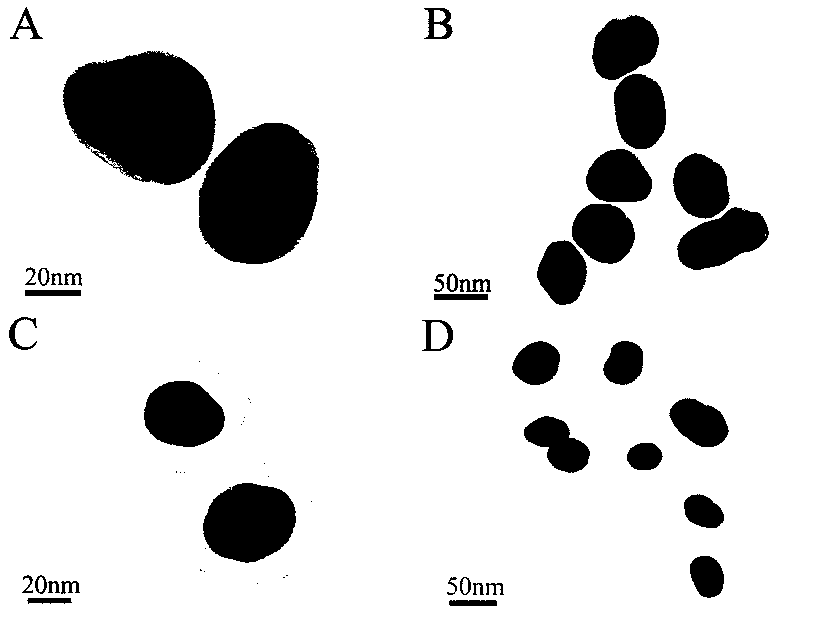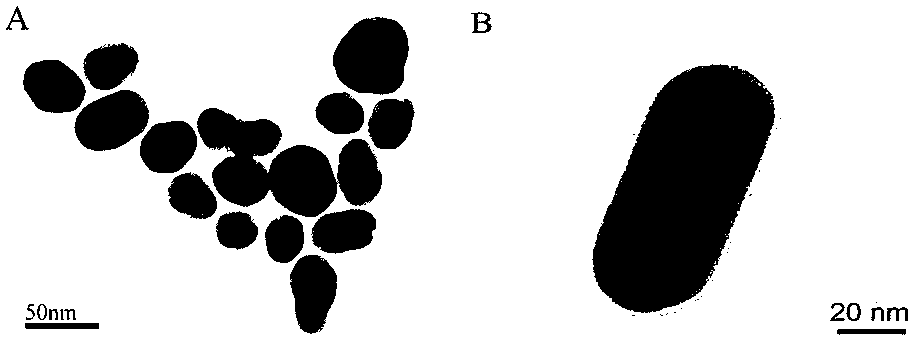Selective detection method for TNT (trinitrotoluene) by enhanced Raman spectrometry of functionalized shell isolated nanoparticles
A nanoparticle and Raman spectroscopy technology, which is applied in the field of selective detection of TNT by enhanced Raman spectroscopy, can solve problems affecting the accuracy of SERS spectra, charge transfer, and easy destruction of the shell, and achieve a good SERS enhancement effect Effect
- Summary
- Abstract
- Description
- Claims
- Application Information
AI Technical Summary
Problems solved by technology
Method used
Image
Examples
Embodiment 1
[0041] TEM characterization of functionalized shell-insulated nanoparticles with different shell thicknesses:
[0042] Au PAT with different shell thicknesses was obtained by controlling the concentration of o-mercaptoaniline and surfactant sodium dodecyl sulfate. The obtained solution was repeatedly washed until the supernatant in the centrifuge tube was colorless, and then the obtained centrifuged bottom liquid was dropped onto a copper grid for testing. The shell thickness of the obtained Au PAT particles was about 2 , 4, 10 and 30 nanometers, the size of gold nanoparticles is about 50 nanometers, such as figure 2shown. At the same time, it should be noted that before and after the modification of gold nanoparticles, the solution changed from wine red to violet.
Embodiment 2
[0044] TEM characterization of gold nanoparticles with different shapes and particle sizes (20nm to 50nm) as the core functionalized shell-isolated nanoparticles:
[0045] Centrifuge the prepared gold sol, and then mix gold nanoparticles with different particle sizes (the particle size ranges from 20 nm to 50 nm), or use gold nanorods instead of gold nanospheres as the core, and add o-mercaptoaniline After the Au PAT nanoparticle solution obtained after the reaction was centrifuged and cleaned, and then dropped on the copper grid obtained TEM figure, the results are as follows image 3 shown.
Embodiment 3
[0047] SERS characterization of nanoparticles with gold nanoparticles as the core and 2 nm poly-o-mercaptoaniline as the shell (Au2 nm PAT) under different pH conditions:
[0048] The obtained Au2 nm PAT was placed in solutions with different pH values, and then used as a SERS substrate, and then added with 10 -3 mol / L TNT solution for Raman testing. Observe the acid and alkali resistance of this particle from the change of SERS spectrum, such as Figure 4 shown. When the pH of the solution is 6.86, the measured TNT signal is the best. When the pH is 2.02 and 12.95, the measured TNT signal is relatively poor. When it is less than 2.02 or greater than 12.95, the TNT signal cannot be detected. It can be judged that the nanoparticles have been completely destroyed and can no longer be used, so that the applicable pH range of the SERS substrate is 2.02-12.95.
PUM
| Property | Measurement | Unit |
|---|---|---|
| Thickness | aaaaa | aaaaa |
| Thickness | aaaaa | aaaaa |
| Particle size | aaaaa | aaaaa |
Abstract
Description
Claims
Application Information
 Login to View More
Login to View More - R&D
- Intellectual Property
- Life Sciences
- Materials
- Tech Scout
- Unparalleled Data Quality
- Higher Quality Content
- 60% Fewer Hallucinations
Browse by: Latest US Patents, China's latest patents, Technical Efficacy Thesaurus, Application Domain, Technology Topic, Popular Technical Reports.
© 2025 PatSnap. All rights reserved.Legal|Privacy policy|Modern Slavery Act Transparency Statement|Sitemap|About US| Contact US: help@patsnap.com



